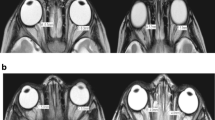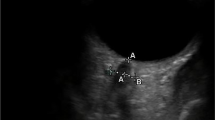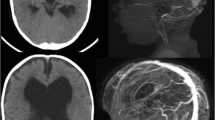Abstract
Purpose
We aimed to evaluate whether optic nerve sheath diameter (ONSD) measurement by computed tomography (CT) can be a diagnostic criteria for the detection of ventriculoperitoneal shunt dysfunction among children whose fontanels are still open.
Methods
Patients with a ventriculoperitoneal shunt who were currently showing clinical and radiological signs of acute hydrocephalus depending on the shunt dysfunction were included in this study. The study was designed to compare the preoperative and postoperative ONSDs of three groups of patients divided according to their ages: group 1, patients aged < 4 months; group 2, patients aged 4–18 months; and group 3, patients aged > 18 months.
Results
We included 138 patients (mean age, 35.18 ± 51.01 months). Among the patients, 46.4% were females and 53.6% were males. ONSD measurements in the preoperative period were < 2.86 ± 0.59 in group 1, 3.93 ± 0.82 in group 2, and 5.40 ± 0.81 in group 3 and those in the postoperative period were 2.02 ± 0.38 in group 1, 2.72 ± 0.62 in group 2, and 3.64 ± 0.81 in group 3. Right, left, and mean ONSDs increased significantly in the three groups and were found to be statistically significant.
Conclusion
ONSD measurement in CT has been evaluated as an appropriate finding that can be used especially in acute hydrocephalus, when clinical and radiological findings are not diagnostic.


Similar content being viewed by others
Data availability
Data and materials can be provided upon request.
Code availability
Not applicable
References
Baykaner K, Ersahin Y, Mutluer S, Ozek M. Pediatric Neurosurgery. Turkisc Neurosurgery Society Publications, No:15. Ankara, 2014. Selection and types of shunts in the treatment of hydrocephalus. Hicdonmez T.
Hanak BW, Bonow RH, Harris CA, Browd SR (2017) Cerebrospinal fluid shunting complications in children. Pediatr Neurosurg 52:381–400. https://doi.org/10.1159/000452840
Hanak BW, Ross EF, Harris CA, Browd SR, Shain W (2018) Toward a better understanding of the cellular basis for cerebrospinal fluid shunt obstruction: report on the construction of a bank of explanted hydrocephalus devices. J Neurosurg Pediatr 18:1–11
Greenberg MS (2010) Handbook of Neurosurgery. In: (ed) Greenberg MS. Hydrocephalus. Thieme, New York, 307-337
Salahuddin N, Mohamed A, Alharbi N, Ansari H, Zaza KJ, Marashly Q, Hussain I, Solaiman O, Wetterberg TV, Maghrabi W, Maghrabi K (2016) The incidence of increased ICP in ICU patients with non-traumatic coma as diagnosed by ONSD and CT: a prospective cohort study. BMC Anesthesiol 16:106. https://doi.org/10.1186/s12871-016-0267-1
Tayal VS, Neulander M, Norton HJ, Foster T, Saunders T, Blaivas M (2007) Emergency department sonographic measurement of optic nerve sheath diameter to detect findings of increased intracranial pressure in adult head injury patients. Ann Emerg Med 49:508–514
Sönmez BM, Temel E, Iscanlı MD, Yılmaz F, Guloksuz U, Parlak S, Uckun OM (2019) Is initial optic nerve sheath diameter prognostic of specific head injury in emergency departments? J Nat Med Assoc 111:210–217. https://doi.org/10.1016/j.jnma.2018.10.009
D’Antoni AV, Donaldson OI, Schmidt C, Macchi V, De Caro R, Oskouian RJ, Loukas M, Tubbs RS (2017) A comprehensive review of the anterior fontanelle: embryology, anatomy, and clinical considerations. Childs Nerv Syst 33:909–914. https://doi.org/10.1007/s00381-017-3406-1
Isık N (2017) Physical examination and neurological evaluation in craniosynostosis cases; icpi, hydrocephalus, mental status, epilepsy, endocrine problems, additional malformations. Türk Nöroşir Derg 27:278–285
Helmke K, Hansen HC (1996) Fundamentals of transorbital sonographic evaluation of optic nerve sheath expansion under intracranial hypertension. II Patient study. Paedaitr Radiol 26:706–710
Lin SD, Kahne KR, El Sherif A, Mennitt K, Kessler D, Ward MJ, Platt SL (2019) The use of ultrasound-measured optic nerve sheath diameter to predict ventriculoperitoneal shunt failure in children. Pediatr Emerg Care 35:268–272
Shirodkar CG, Munta K, Rao SM, Mahesh MU (2015) Correlation of measurement of optic nerve sheath diameter using ultrasound with magnetic resonance imaging. Indian J Crit Care Med 19(8):466–470
Bhandari D, Bidkar PU, Adinarayanan S, Narmadhalakshmi K, Srinivasan S (2019) Measurement of changes in optic nerve sheath diameter using ultrasound and computed tomography scan before and after the ventriculoperitoneal shunt surgery in patients with hydrocephalus - a prospective observational trial. Br J Neurosurg. 33:125–130
Zaidi SJH, Yamamato LG (2014) Optic nerve sheath diameter measurements by CT scan in ventriculoperitoneal shunt obstruction. Hawaii J Med Public Health 73:251–255
Yapicioglu H, Aslan N, Sertdemir Y, Yildizdas D, Gulasi S, Mert K (2020) Determination of normal values of optic nerve sheath diameter in newborns with bedside ultrasonography. Early Hum Dev 145:104986. https://doi.org/10.1016/j.earlhumdev.2020.104986
Ballantyne J, Hollman AS, Hamilton R, Bradnam MS, Carachi R, Young DG, Dutton GN (1999) Transorbital optic nerve sheath ultrasonography in normal children. Clin Radiol 54:740–742
Janthanimi P, Dumrongpisutikul N (2019) Pediatric optic nerve and optic nerve sheath diameter on magnetic resonance imaging. Pediat Radiol 49:1071–1077. https://doi.org/10.1007/s00247-019-04404-6
Beare NAV, Kampondeni S, Glover SJ, Molyneux E, Taylor TE, Harding SP, Molyneux ME (2008) Detection of raised intracranial pressure by ultrasound measurement of optic nerve sheath diameter in African children. Trop Med Int Health. 13(11):1400–1404
Chinta S, Wallang BS, Sachdeva V, Gupta A, Patil-Chhablani P, Kekunnaya R (2014) Etiology and clinical profile of childhood optic nerve atrophy at a tertiary eye care center in South India. Indian J Ophthalmol 62:1003–1007. https://doi.org/10.4103/0301-4738.145996
Liu M, Yang ZK, Yan YF, Shen X, Yao HB, Fei L, Wang ES (2020) Optic nerve sheath measurements by computed tomography to predict intracranial pressure and guide surgery in patients with traumatic brain injury. World Neurosurg 134:e317–ee324. https://doi.org/10.1016/j.wneu.2019.10.065
Wilk R, Kluczewska E, Syc B, Bajor G (2011) Normative values for selected linear indices of the intracranial fluid spaces based on CT images of the head in children. Pol J Radiol 76:16–25
Acknowledgments
This article is partly supported by the Turkish Neurosurgical Society.
Funding
This research did not receive any specific grant from funding agencies in the public, commercial, or not-for-profit sectors.
Author information
Authors and Affiliations
Contributions
Conception and Design: Pinar Aydin Ozturk, Muhammet Asena
Acquisition, analysis and interpretation of data: Pinar Aydin Ozturk, Muhammet Asena
Approved final version of the manuscript: Pinar Aydin Ozturk, Muhammet Asena
Corresponding author
Ethics declarations
Ethics approval
The study was approved by the Ethics Committee of the Health Sciences University, Gazi Yasargil Education and Research Hospital (Approval number 476; May 15, 2020).
Consent to participate
The study was conducted in accordance with the Declaration of Helsinki, and informed written consent was obtained from the parents of all patients.
Consent for publication
The authors have consented for publication.
Conflict of interest
The authors declare no conflicts of interest.
Additional information
Publisher’s note
Springer Nature remains neutral with regard to jurisdictional claims in published maps and institutional affiliations.
Rights and permissions
About this article
Cite this article
Aydin Ozturk, P., Asena, M. Determination of ventriculoperitoneal shunt dysfunction using optic nerve sheath diameter measurement on CT scan in pediatric patients with hydrocephalus. Childs Nerv Syst 37, 1895–1900 (2021). https://doi.org/10.1007/s00381-021-05097-9
Received:
Accepted:
Published:
Issue Date:
DOI: https://doi.org/10.1007/s00381-021-05097-9




